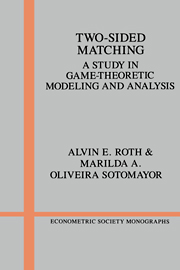Chapter 1 - Introduction
Published online by Cambridge University Press: 05 January 2013
Summary
The purpose of this book is two-fold. First, it reviews and integrates the growing literature about a family of models of labor markets, auctions, and other economic environments. Second, we hope it will illustrate the subtle interactions between modeling considerations and mathematical analysis that characterize the use of game theory to explain and predict the behavior of complex “real-world” economic systems.
We will be concentrating on “two-sided matching markets.” The term “two-sided” refers to the fact that agents in such markets belong, from the outset, to one of two disjoint sets - for example, firms or workers. This contrasts with commodity markets, in which the market price may determine whether an agent is a buyer or a seller. Thus whereas the market for gold has both sellers and buyers, any particular agent might be a buyer at one price and a seller at another, so the market is not two-sided in the sense we will speak of. But a labor market often is, since firms and workers are distinct. For example, as the wages of professors fall, some professors may leave the market, but none will become universities. The term “matching” refers to the bilateral nature of exchange in these markets - for example, if I work for some firm, then that firm employs me. This contrasts with markets for goods, in which someone may come to market with a truck full of wheat, and return home with a new tractor, even though the buyer of wheat doesn't sell tractors, and the seller of tractors didn't buy any wheat.
- Type
- Chapter
- Information
- Two-Sided MatchingA Study in Game-Theoretic Modeling and Analysis, pp. 1 - 14Publisher: Cambridge University PressPrint publication year: 1990



